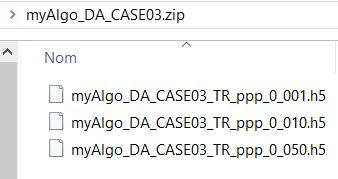Second DA Challenge datasets, Case 3: Rayleigh-Bénard convection
The present page describes the input data as well as rules for submitting results (with corresponding download/upload links in the left panel), for Case 3 of the 2nd DA Challenge. Published results can be found on this page.
This test case consists of the reconstruction of velocity and pressure fields from scattered particle positions generated synthetically from a DNS provided by Mohammad Shah Emran and Ola Shishkina at MPI-DS. As an optional component of this case, participants may also attempt reconstruction of temperature fields.
1. Domain of interest and setup
The virtual experiment was generated by initializing a uniform random distribution of particles in the domain and advecting massless particles using the spatially interpolated DNS velocity data with a fourth order Runge-Kutta scheme. Due to the enclosed nature of the measurement no particles enter or exit the domain so the number of particles across all timesteps or all tracks is constant. We provide perfect tracking in the sense that no tracks are disconnected, end prematurely, or are falsely connected. Measurement error of 0.1px is simulated by adding noise to the advected particle positions drawn from a Normal distribution with a corresponding standard deviation. The added error is doubled in the ydirection to represent nonuniform error in a “depth” direction.
2. Input data
A series of 100 timesteps is provided for each seeding density at a simulated acquisition frequency of approximately 33 Hz ( dt= 30.3228 ms).
We provide simulated tracks at three different seeding densities. Participants submitting entries for this case must submit results for all three. Beyond the velocity and pressure reconstruction also targeted by the other DA cases we also use this case to test out temperature reconstruction as well. Participants attempting this shall include temperature in their submission data but this is an optional component of this case.
Particles are provided in a text file per timestep with their position in mm and a numeric track ID allowing them to be assembled into tracks. These files follow the naming scheme “DA_CASE03_TR_ppp_0_AAA_PartFile_BBBB.dat” with AAA the fractional part of seeding density, and BBBB as a time step index starting from zero.
3. Requested cases and formatting rules for upload
3.1. Mandatory cases
All seeding density cases should be processed and uploaded. For each, the flow field for the central time step, corresponding to file DA_CASE03_TR_ppp_0_AAA_PartFile_0049.dat, needs to be supplied.
3.2. Requested data and file formatting
Participants shall provide their results on an output grid covering the interior of the domain with a fixed 2 mm spacing. A cube grid with lower corner at (2mm, 2mm, 2mm) , upper corner at (198mm, 198mm, 198mm) and (99,99,99) points. The submitted pressure values shall be offset corrected by subtracting the pressure value at the central grid point (0.1m, 0.1m, 0.1m).
The output files are requested in HDF5 format, using the following naming convention:
“ZZZZ_DA_CASE03_TR_ppp_0_AAA.h5”, with AAA the fractional part of seeding density, and ZZZZ is a free string to identify your result (free number of characters), but should contain no space.
This file should include the datasets using the following names:
- Velocity components: VX, VY, VZ in m/s
- Velocity gradient components: dVXdX, dVXdY, dVXdZ, dVYdX, dVYdY, dVYdZ, dVZdX, dVZdY, dVZdZ in 1/s
- Static pressure: p in Pa
- (OPTIONAL) Temperature: T in K
The data arrays shall be in column major (fortran) order flattened to a 1d array. Sample scripts generating such .h5 files with the expected format are available for download in Matlab and Python. Note that these correspond to the specific case of the 1st DA Challenge held in 2020, so they should be adapted e.g. in terms of number of mesh points, etc.
3.4. Preparing your upload
Once your .h5 files are produced, please make sure that you zip them directly (do not zip a folder containing them, as this will result in the submission being rejected) into a single archive, as in the example of myAlgo_DA_CASE03.zip below:

3.4. Upload form
Once your zip archive is ready, clicking on "Submit TP results" or on "Submit TR results" will open a form allowing you to upload a file containing your results.
The upload form should also be filled with the following information, which is used for result presentation only if you choose to publish your result based on the evaluation sent by email:
- List of authors (default: submitter name)
- Authors' institution(s) (default: submitter institution)
- Optional: departement / team (default: submitter's departement / team)
- Algorithm's short name or acronym
- Algorithm's full name
- Optional: URL address of the publication on your algorithm, or of a webpage describing it
For these fields, note that rules apply, in terms of maximum length and/or authorized characters. These are displayed on the form in the explanatory text of each field. In particular, commas are not allowed in any of the above fields.
Contact in case of questions: Philipp Godbersen and Andreas Schröder, DLR: philipp.godbersen@dlr.de, andreas.schroeder@dlr.de.
